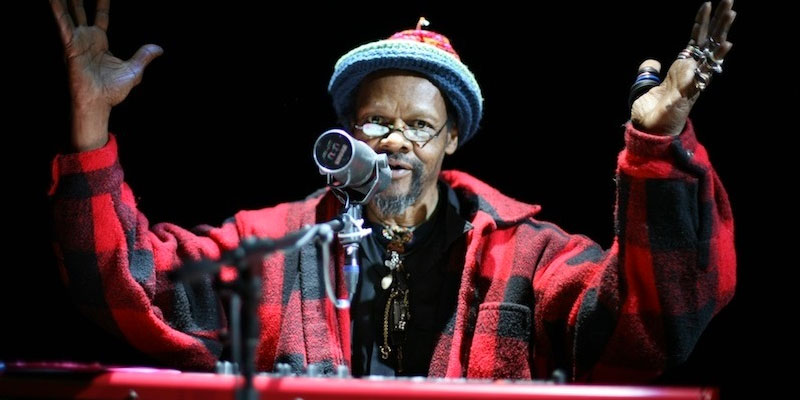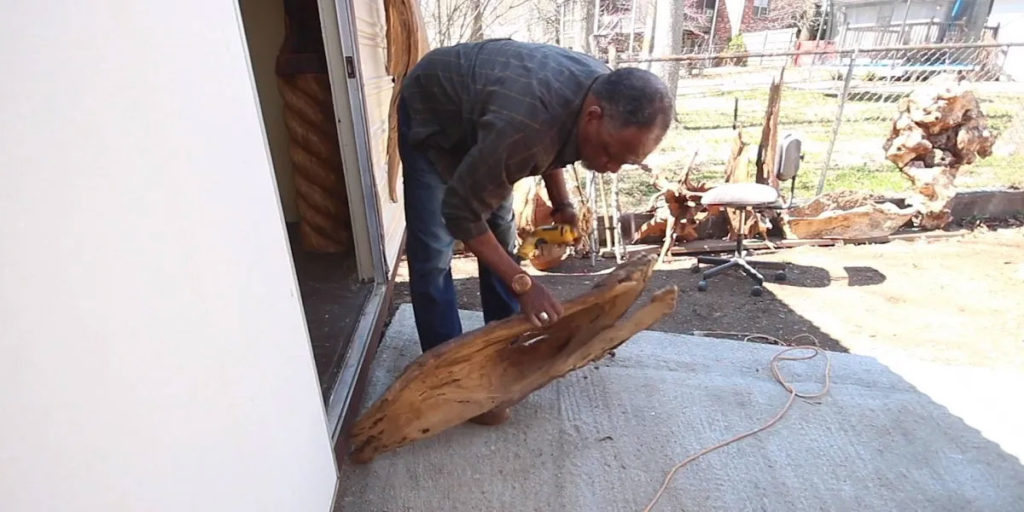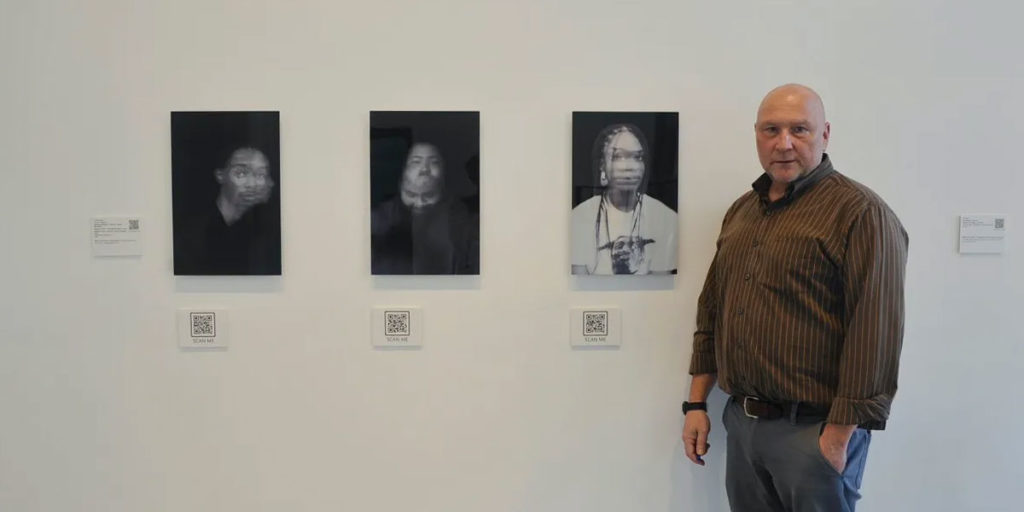Lonnie Holley sees things. Standing in a dirt lot in Williamsburg, Brooklyn, he spied a piece of rusty metal, a bit of blue string, a broken yellow broom handle, a plastic spoon.
“If you don’t mind, would you step away from the camera and get me that rottening piece of tin right there,” he directed. “Now get me that blue piece of thing while you’re at it. Beautiful. Just like that.”
Holley has an intuitive vision for how each piece will fit together and it extends beyond the strewn-about items. From the helicopter flying overhead to the utility pole at the edge of the lot leaning under the weight of a gaggle of wires, a bright pink wall to the right, and a garbage truck rumbling by. Each instance provides Holley with a chance to weave a parable about interconnectedness. Each piece of “garbage” will be salvaged and transformed.
“The reason why I choose to use some things is from the strength of the objects themselves,” he said. “It’s something that has to have something going on for it. For something that’s a piece of trash or garbage and you get it and you fall in love with it because it’s a new idea.”
Lonnie Holley creates permanent art out of cast-off materials from Alabama NewsCenter on Vimeo.
Lonnie Bradley Holley Sr. is an artist, musician, filmmaker and educator. He grew up in Birmingham, one of 27 children in his family, during the Jim Crow era. He began making art in 1979 after his niece and nephew died in a house fire. His sister couldn’t afford to buy grave markers, so he took some cast-off sandstone from the nearby steel foundry and carved tombstones out of that material. Not only did that make her happy, but he found that process to be very cathartic. He continued creating sandstone carvings and began making sculptures and assemblages out of other found objects.
“He was making art generally about things that he saw happening in the world,” said Matt Arnett, Holley’s manager. “Eventually that stuff found its way into museums, and people started recognizing its importance.”
That includes a groundbreaking exhibition, “More Than Land or Sky: Art from Appalachia,” at the Smithsonian’s National Museum of American Art in 1981.
“Artists like Lonnie came of age during the civil rights movement, were heavily inspired by that movement and they had something to say, too,” Arnett said. “They were inspired by the civil rights movement to come out and start making work. The consequences of having your thoughts and ideas be known, it could be fatal.”
Holley is part of a wave of self-taught Alabama artists that includes Thornton Dial, Joe Minter and others, most of whom were collected and championed by Arnett’s father, William Arnett, founder of the Souls Grown Deep Foundation that gifted a large number of works to the Metropolitan Museum of Art in New York City in 2014. Those works were in a 2018 Met exhibition called “History Refused to Die.”
“It was a slow process,” Arnett said. “It’s not until recently that Lonnie’s work has been entering the most esteemed art museums in the world.”
His pieces are now in permanent collections of the Smithsonian American Art Museum, the Whitney Museum of American Art, the Met and others.
“I didn’t understand that, just being a simple African-American, self-taught, never having a proper education, could come into an art world like this now,” Holley said. “Think about my works being in the Smithsonian within four months after I start creating. And now my works are on a permanent exhibition at the United Nations. On a permanent exhibition in the Smithsonian.”
Holley continued to make art at his family’s homestead in Birmingham for many years, eventually turning the area into a large art environment. That was bulldozed by the city in 1997 to make way for airport expansion. He moved to nearby Harpersville for a while before relocating to Atlanta in 2010.
A few years after making those first tombstones, Holley found an old Casio keyboard in a Goodwill shop in Birmingham and started making music. “He did that privately,” Arnett said. “He didn’t expect that anyone would hear his music. If you were lucky enough to show up at his house when he was making art and he had the keyboard out, you might have heard it.”
At age 62, when most folks are starting to think about retirement, Holley began releasing recorded music commercially, first through the Atlanta-based Dust-to-Digital, and more recently via hipster label Jagjaguwar. “I started going into the studio very late in life,” he said with a smile. “But I had been singing and moaning and groaning like my grandmama and granddaddy and them, and I think their mama and granddaddy and them did the same thing.”
The New York Times calls his music haunting and unclassifiable. The New Yorker uses words like melange and shamanistic. NPR says droney and nocturnal.
“I think the music I make now is just like my art; it’s a lesson, it’s all a lesson,” he said. “I’ve been telling everybody ever since I got on the music scene or went into a studio, I sung about it, how my music and my art is like Siamese twins. They’re oneness, coming from the same brain.”
“He says often, ‘I didn’t come here to make you dance. You might not like everything I’m here to tell you,’” said Arnett. “There’s not anybody else like him.”
Holley’s performances are heavy on improvisation, which means you’ll never see the same exact thing twice. His unique sound and its immersive experience has gotten the attention not just of the top-tier music critics, but also of wildly popular indie musicians like Animal Collective, Deerhunter and Bon Iver, and he’s performed or toured with each.
While Holley’s sound can be dreamy and avant-garde, his lyrical themes often have a heavy socio-political bent. Holley’s “Mith” album includes tracks like “I’m A Suspect” and “I Snuck Off the Slave Ship.”
“His message has been consistent for the three decades that he’s been making music,” Arnett said. “It’s just taken the rest of the world that long to catch up with the ideas of what he’s trying to teach us about ourselves and our country and the environment.”
“Mith” just celebrated its 1-year anniversary. Holley has spent much of that time on the road.
In a recent Facebook post he wrote, “I’ve been to a lot of islands this year, and that will continue. Australia, Tasmania, Aoteoroa/New Zealand’s North and South Islands, the UK, and just yesterday, Horn Island. Coming up later this summer will be Madeira Island and Sardinia.”
Holley is playing shows around the U.S. for most of the rest of 2019, including a recent gig at the Ogden Museum of Southern Art in New Orleans, where he will unveil a new sculpture.
Holley added the title of director to his resume last year. His short film, “I Snuck Off the Slave Ship,” premiered at the Sundance Film Festival earlier this year. Named for the song from the “Mith” album, the film is described as “an assemblage of Holley’s encounters with the slave ship ‘America’ and a testament to imagination as resistance.”
Next year will finally see the release of “Thumbs Up for Mother Universe: The Lonnie Holley Story,” the full-length documentary by Director George King that has been germinating for more than 20 years.
“I always was more like a planter, the one that puts the seeds in the ground and give them time to grow and teach somebody how to harvest from that,” Holley said. “So, with that kind of message as an artist, that’s what I go out into the world and work with.”
(Courtesy of Alabama NewsCenter)













